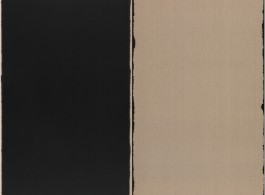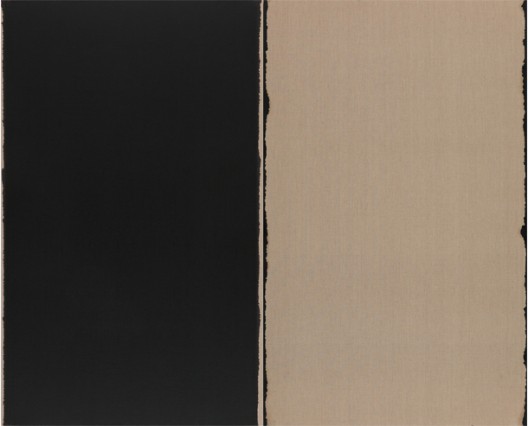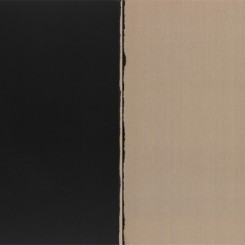Opening 04.02.2016 – 6-9pm
Axel Vervoordt Gallery Antwerp is pleased to present its solo exhibition of Yun Hyong-Keun (Miwon, 1928 – Seoul, 2007), who was a member of the Korean art movement Dansaekhwa. Yun is best known for his paintings with superposed umber and ultramarine oil paint, works with dark, rectilinear forms enveloped by lighter areas, that he delicately developed for forty years. Yun was inspired by the art of ink brush writing master Kim Jeong-Hui (pen name Chusa) and by nature. In 1976 the artist had a life shaping experience when he saw a massive, rotting tree and was overwhelmed by nature’s magnitude and mystery: “I want to make paintings that, like nature, one never tires of looking at. That is all I want in my art.” (1)
Even before that memorable moment, nature was of inspiration for his palette. After the basic compositions with bright colours and thick encrustations of paint of his early work, his paintings drastically changed when one day in 1967 he placed a raw canvas on his studio floor and inscribed upon it several vertical stripes in two alternating colours: umber, the colour of earth, and ultramarine, the colour of water. Later, he merged them, one on top of the other in an unceremonious routine, to create an intense and velvety darkness.
The same tree that re-ignited and fuelled his reverence for nature also made him muse on time: “It is just a matter of time before everything that stands on the earth will return to dirt. When I think of how I, and my paintings too, will also in due time be reduced to dust, it strikes me that nothing in this world is that tremendous. But at the same time, during the limited time that I have life here, I can keep a record – all I can do is keep a record, day by day, that serves as evidence, as a trace of the flame that is my life.” (2)
In other words, Yun’s works are evidence of a being in time, of a living existence that changed face with the passage of time. (3) But his art is not only a trace of his time, he also transcribed time into it. He added turpentine solvent to the painted umber and blue. Absorbed by the support at a faster rate than the oil, the solvent encroached slowly upon the unpainted areas, leaving behind one, two, and sometimes more penumbras, a seepage that was enhanced by Yun’s turn to hemp and linen rather than canvas as the support, that was untreated save for a light application of oxhide glue. He did this to find the watery viscosity of ink and he used ink brushes of different sizes, as he wanted to continue the core ethos of Kim’s abstract ink writing art. (4)
Another way he encapsulated time in his art was by coming back to it again and again. Underneath the simple construction of abstract forms, his paintings contain an accumulation of procedures performed at various moments, as his method was to make one layer of brushstroke and leave it until a later encounter with the work: “It takes several days to complete one work, sometimes months.” (5) Why did he follow this unceremonious routine? “It is to erase what the eye sees in the present.” (6) A last way time seeped into his work, is the delicate metamorphosis it underwent: the forms grew larger, darker, and fewer in number. (7)
Yun was interested in the organization of those forms and the spaces between them. By the mid-seventies, these spaces were sometimes so wide as to take up most of the picture plane. Korean audiences of the time described these spaces as jobaek, a word frequently used to refer to the ‘void’ in traditional ink painting. Yun, however, who never used this word himself in reference to his work, emphasized the materiality of these spaces by leaving them unpainted. For him, the challenge lay in thinking about the role of unmarked spaces without having to appeal to ideas like the void, which tended to be invoked within the contemporary art context as a metaphor of Asian-ness. (8)
The uneven rates of absorption of the solvent and diluted oil point to the role he destined to unmarked spaces. He wanted the eye to move laterally across the canvas, so that the painting, despite its separate forms, is again visible as a holistic unit. When Yun encountered the works of Mark Rothko at the Museum
of Modern Art in July 1974, a strong feeling of affinity came over him. (9) Rothko’s absorbing works intensified his belief in the possibility of dividing pictorial space without allowing such organization to become the work’s exclusive focus, an ambition that indicates that Yun’s sparse, abstract art and practice was geometric nor gestural, but centred on a repeated process of a physical action in a period of time.
Born in 1928 as the third of six children, Yun spent his twenties during a dark period of Korean history. In 1947 he entered Seoul National University to study Western painting, but he abandoned his studies after he was imprisoned for his involvement with the leftist student movement. He returned to his hometown, Cheongju, where he worked as a teacher. Only eight months later, the Korean War (1950-53) broke out, a tumultuous time in which he miraculously escaped from a firing squad. Yun survived the war and in 1954 he entered Hongik University. There, he met Kim Whanki, a renowned painter and his future father-in-law, and forged a close relationship with the art students who would be exponents of Dansaekhwa.
Yun had many solo exhibitions in South Korea and Japan, and his work has been exhibited internationally in museums including National Museum of Modern and Contemporary Art Seoul, Tokyo Metropolitan Art Museum, Tate Liverpool, Donald Judd Foundation in New York, Chinati Foundation in Texas, Total Museum of Contemporary Art in Seoul, Stiftung für Konkrete Kunst in Reutlingen, Art Sonje Museum in Gyeongju, and Musée d’Art Moderne et Contemporain, Strasbourg. Over the time Yun’s work has been collected by many public institutions, for example in South Korea (National Museum of Modern and Contemporary Art, Leeum Samsung Museum of Art, Amorepacific Museum of Art, Ho-Am Art Museum), in Japan (Fukuoka Art Museum, Kitakyushu Municipal Museum of Art, Hiroshima City Museum of Contemporary Art, Mie Prefectural Art Museum), in Hong Kong (M+ Museum), in Germany (Stiftung für Konkrete Kunst), and in the USA (Chinati Foundation). In 1969 Yun’s work was included in the 10th São Paulo Biennale and in 1995 the artist was invited to participate in the inaugural exhibition of the Korean Pavilion during the 46th Venice Biennale.
Recently, major Asian museums and international scholars started to revisit Yun’s work, its quality and art historical importance, as well as Yun’s important contribution to the art movement Dansaekhwa alongside other leading artists Lee Ufan, Chung Chang-Sup, Chung Sang-Hwa, Ha Chong-Hyun, Kim Whanki, Kwon Young-woo, and Park Seo-Bo. (10) Dansaekhwa (or Tansaekhwa, depending on which Romanization system is used) is a Korean noun phrase which means ‘single-colour’ painting. It emerged in the late 1960s and began to take root in the early 1970s, but it was never an official movement. There was no consolidated group of artists who worked together toward actualizing a manifesto. The artists to whom this rubric was retroactively attributed by critics like Lee Yil and Nakahara Yusuke, did, however, exhibit in the same shows and even occasionally painted together. What they all had in common was a commitment to thinking more intensively about mark, line, frame, surface, and space and to the process of a physical action that occupied a period of time and took place in a set space.
—–
(1) Writings by the artist, ‘A Thought in the Studio (1976)’, in YUN HYONG-KEUN, exh. cat., PKM Gallery (15 April – 17 May
2015), Seoul: PKM Gallery, 2015: p 10.
(2) Ibid.
(3) Kyung-Sung Lee, Yun, Hyong-keun, exh. cat., Ingkong Gallery, Seoul, 1991: p. 8
(4) Kai Hong, ‘Yun Hyong-Keun’s Painting as an Embodiment of the Spirit of Daam’, in YUN HYONG-KEUN: p. 14, 17.
(5) Writings by the artist, ‘Jingtongmante [A Million Forms of Pain]’, in Kyunghyang Shinmun, 3 February 1977.
(6) Ibid.
(7) Richard Vine, ‘In the Fullness of Time’, in YUN HYONG-KEUN: p. 3.
(8) Joan Kee, ‘Kwon Young-woo and Yun Hyongkeun Rethinking Painting’, in Joan Kee, Contemporary Korean Art – Tansaekhwa and the Urgency of Method, Minnesote: University of Minnesota Press, 2013: p. 82.
(9) Ibid.: p. 87.
(10) Both the exhibition Dansaekhwa: Korean Monochrome Painting at the National Museum of Contemporary Art of Korea, curated by Yoon Jin Sup in 2012, and the publication Contemporary Korean Art – Tansaekhwa and the Urgency of Method written by Joan Kee in 2013, can be seen as catalysts of this growing interest. Last year the Estate of Yun Hyong-Keun published the first comprehensive and in-depth monograph on his body of work.



